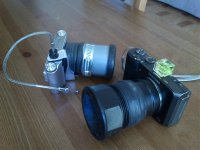Hi! I have made adapters for two of my compact cameras (see attached photo). One is a Samsung NV40 and the other a Samsung EX1. The adapters are attached (easily detachable) to the cameras and slide over the eyepiece of the spotting scope (in my case a Brunton Eterna 80ED) all the way down until they rest on the spotting scope body. The NV40 is triggered by wire, the EX1 by remote control.
Both adapters are mainly made of plastic tube parts found in the local hardware/plumbing shop. Cutting to the correct length is important. For the NV40 the tube is attached to the camera with a aluminium plate attached to the tube with a hose clamp and by the camera tripod screw. For the EX1 I bought the filter adapter tube that can be screwed on to the front of the camera, then I attached it to a piece of plastic tube. Vulcanizing tape (the kind of rubber tape that attaches to itself after being stretched) has been very useful.
The NV40 works as "expected" for a 3x zoom in which the vigneting effect can be cropped out by zooming. This does however NOT work for my EX1. For a good image the lens has to be very near to the lens of the eyepiece (This is the tricky part in making the home-made adapter). Zooming is just increasing the vigneting effect and the front lens hits the eyepiece. However, it takes very nice photos without zooming, and then they can be cropped in the camera (or computer) afterwards. The advantage with the EX1 is its nice optics and very fast lens (f1.8). Both cameras are nice in the way that they allow manual settings and that the settings remain after the camera is turned off (or turns itself off).
Cheap, relatively easy to make, light-weight, swiftly applied when in the field, and with (in my opinion) good results.
Both adapters are mainly made of plastic tube parts found in the local hardware/plumbing shop. Cutting to the correct length is important. For the NV40 the tube is attached to the camera with a aluminium plate attached to the tube with a hose clamp and by the camera tripod screw. For the EX1 I bought the filter adapter tube that can be screwed on to the front of the camera, then I attached it to a piece of plastic tube. Vulcanizing tape (the kind of rubber tape that attaches to itself after being stretched) has been very useful.
The NV40 works as "expected" for a 3x zoom in which the vigneting effect can be cropped out by zooming. This does however NOT work for my EX1. For a good image the lens has to be very near to the lens of the eyepiece (This is the tricky part in making the home-made adapter). Zooming is just increasing the vigneting effect and the front lens hits the eyepiece. However, it takes very nice photos without zooming, and then they can be cropped in the camera (or computer) afterwards. The advantage with the EX1 is its nice optics and very fast lens (f1.8). Both cameras are nice in the way that they allow manual settings and that the settings remain after the camera is turned off (or turns itself off).
Cheap, relatively easy to make, light-weight, swiftly applied when in the field, and with (in my opinion) good results.




